Deeply Derived Magma Controlling the Polymetallic Mineralization at Shuikoushan, South China: Constraints from Mineral U–Pb Dating and Whole-Rock Geochemistry
Abstract
:1. Introduction
2. Geological Setting
3. Deposit Geology
4. Sampling and Analytical Methods
4.1. Zircon U–Pb Chronology
4.2. Apatite U–Pb Chronology
4.3. Garnet U–Pb Chronology
4.4. Whole Rock Geochemistry
5. Results
5.1. Zircon U–Pb Dating
5.2. Apatite U–Pb Dating
5.3. Garnet U–Pb Dating
5.4. Whole-Rock Major and Trace Element Abundance
6. Discussion
6.1. Timing of Magmatism and Polymetallic Mineralization
6.2. Magma Generation in Extensional Setting
6.3. Magma Oxidation and Metallogenic Potential
6.4. The Development of Skarn and Hydrothermal System
6.5. Implications for Mineral Exploration
7. Conclusions
Supplementary Materials
Author Contributions
Funding
Data Availability Statement
Acknowledgments
Conflicts of Interest
References
- Blanks, D.E.; Holwell, D.A.; Fiorentini, M.L.; Moroni, M.; Giuliani, A.; Tassara, S.; González-Jiménez, J.M.; Boyce, A.J.; Ferrari, E. Fluxing of mantle carbon as a physical agent for metallogenic fertilization of the crust. Nat. Commun. 2020, 11, 4342. [Google Scholar] [CrossRef] [PubMed]
- Hou, Z.; Zhou, Y.; Wang, R.; Zheng, Y.; He, W.; Zhao, M.; Evans, N.J.; Weinberg, R.F. Recycling of metal-fertilized lower continental crust: Origin of non-arc Au-rich porphyry deposits at cratonic edges. Geology 2017, 45, 563–566. [Google Scholar] [CrossRef]
- Lehmann, B. Formation of tin ore deposits: A reassessment. Lithos 2021, 402–403, 105756. [Google Scholar] [CrossRef]
- Richards, J.P.; Mumin, A.H. Lithospheric Fertilization and Mineralization by Arc Magmas: Genetic Links and Secular Differences Between Porphyry Copper ± Molybdenum ± Gold and Magmatic-Hydrothermal Iron Oxide Copper-Gold Deposits. In Tectonics, Metallogeny, and Discovery: The North American Cordillera and Similar Accretionary Settings; Colpron, M., Bissig, T., Rusk, B.G., Thompson, J.F.H., Eds.; Society of Economic Geologists: Littleton, CO, USA, 2013; Volume 17, pp. 277–299. [Google Scholar]
- Locmelis, M.; Fiorentini, M.L.; Rushmer, T.; Arevalo, R.; Adam, J.; Denyszyn, S.W. Sulfur and metal fertilization of the lower continental crust. Lithos 2016, 244, 74–93. [Google Scholar] [CrossRef] [PubMed]
- Elongo, V.; Falck, H.; Rasmussen, K.L.; Robbins, L.J.; Creaser, R.A.; Luo, Y.; Pearson, D.G.; Sarkar, C.; Adlakha, E.; Palmer, M.C.; et al. Ancient roots of tungsten in western North America. Geology 2022, 50, 791–795. [Google Scholar] [CrossRef]
- Leach, D.L.; Bradley, D.; Lewchuk, M.T.; Symons, D.T.; de Marsily, G.; Brannon, J. Mississippi Valley-type lead–zinc deposits through geological time: Implications from recent age-dating research. Miner. Depos. 2001, 36, 711–740. [Google Scholar] [CrossRef]
- Li, W.; Huang, Z.; Zhang, G. Sources of the ore metals of the Huize ore field in Yunnan province: Constraints from Pb, S, C, H, O and Sr isotope geochemistry. Acta. Petrol. Sin. 2006, 22, 2567–2580, (In Chinese with English abstract). [Google Scholar]
- Romer, R.L.; Kroner, U. Phanerozoic tin and tungsten mineralization—Tectonic controls on the distribution of enriched protoliths and heat sources for crustal melting. Gondwana. Res. 2016, 31, 60–95. [Google Scholar] [CrossRef]
- Frimmel, H.E. Earth’s continental crustal gold endowment. Earth Planet. Sci. Lett. 2008, 267, 45–55. [Google Scholar] [CrossRef]
- Greaney, A.T.; Rudnick, R.L.; Gaschnig, R.M.; Whalen, J.B.; Luais, B.; Clemens, J.D. Geochemistry of molybdenum in the continental crust. Geochim. Cosmochim. Acta 2018, 238, 36–54. [Google Scholar] [CrossRef]
- Lee, C.-T.A.; Luffi, P.; Chin, E.J.; Bouchet, R.; Dasgupta, R.; Morton, D.M.; Le Roux, V.; Yin, Q.-Z.; Jin, D. Copper Systematics in Arc Magmas and Implications for Crust-Mantle Differentiation. Science 2012, 336, 64–68. [Google Scholar] [CrossRef]
- Holwell, D.A.; Fiorentini, M.; McDonald, I.; Lu, Y.; Giuliani, A.; Smith, D.J.; Keith, M.; Locmelis, M. A metasomatized lithospheric mantle control on the metallogenic signature of post-subduction magmatism. Nat. Commun. 2019, 10, 3511. [Google Scholar] [CrossRef]
- Richards, J.P. Postsubduction porphyry Cu-Au and epithermal Au deposits: Products of remelting of subduction-modified lithosphere. Geology 2009, 37, 247–250. [Google Scholar] [CrossRef]
- Wang, R.; Weinberg, R.F.; Collins, W.J.; Richards, J.P.; Zhu, D.-C. Origin of postcollisional magmas and formation of porphyry Cu deposits in southern Tibet. Earth-Sci. Rev. 2018, 181, 122–143. [Google Scholar] [CrossRef]
- Zhang, Z.-Y.; Hou, Z.-Q.; Lü, Q.-T.; Zhang, X.-W.; Pan, X.-F.; Fan, X.-K.; Zhang, Y.-Q.; Wang, C.-G.; Lü, Y.-J. Crustal architectural controls on critical metal ore systems in South China based on Hf isotopic mapping. Geology 2023, 51, 738–742. [Google Scholar] [CrossRef]
- Chen, B.; Ma, X.; Wang, Z. Origin of the fluorine-rich highly differentiated granites from the Qianlishan composite plutons (South China) and implications for polymetallic mineralization. J. Asian Earth Sci. 2014, 93, 301–314. [Google Scholar] [CrossRef]
- Sun, W.-D.; Yang, X.-Y.; Fan, W.-M.; Wu, F.-Y. Mesozoic large scale magmatism and mineralization in South China: Preface. Lithos 2012, 150, 1–5. [Google Scholar] [CrossRef]
- Zaw, K.; Peters, S.G.; Cromie, P.; Burrett, C.; Hou, Z. Nature, diversity of deposit types and metallogenic relations of South China. Ore. Geol. Rev. 2007, 31, 3–47. [Google Scholar] [CrossRef]
- Zheng, W.; Mao, J.-W.; Zhao, C.-S.; Yu, X.-F.; Zhao, H.-J.; Ouyang, Z.-X.; Wu, X.-D. Early Cretaceous magmatism and associated polymetallic mineralization in South China: The Tiantang example. Int. Geol. Rev. 2018, 60, 1560–1580. [Google Scholar] [CrossRef]
- Hu, R.-Z.; Zhou, M.-F. Multiple Mesozoic mineralization events in South China—An introduction to the thematic issue. Miner. Depos. 2012, 47, 579–588. [Google Scholar] [CrossRef]
- Hou, Z.; Pan, X.; Li, Q.; Yang, Z.; Song, Y. The giant Dexing porphyry Cu–Mo–Au deposit in east China: Product of melting of juvenile lower crust in an intracontinental setting. Miner. Depos. 2013, 48, 1019–1045. [Google Scholar] [CrossRef]
- Yao, J.; Hua, R.; Qu, W.; Qi, H.; Lin, J.; Du, A. Re-Os isotope dating of molybdenites in the Huangshaping Pb-Zn-W-Mo polymetallic deposit, Hunan Province, South China and its geological significance. Sci. China Earth Sci. 2007, 50, 519–526. [Google Scholar] [CrossRef]
- Jiang, S.-H.; Bagas, L.; Liang, Q.-L. Pyrite Re-Os isotope systematics at the Zijinshan deposit of SW Fujian, China: Constraints on the timing and source of Cu-Au mineralization. Ore. Geol. Rev. 2017, 80, 612–622. [Google Scholar] [CrossRef]
- Yu, Z.; Ling, H.; Chen, P.; Chen, W.; Fang, Q.; Mavrogenes, J. In situ elemental and Sr-Nd isotopic compositions of hydrothermal apatite from the Shazhou U deposit in the Xiangshan complex: Implications for the origins of ore-forming fluids of volcanic related U deposits in South China. J. Asian Earth Sci. 2022, 233, 105230. [Google Scholar] [CrossRef]
- Ding, T.; Ma, D.; Lu, J.; Zhang, R. Magnetite as an indicator of mixed sources for W–Mo–Pb-Zn mineralization in the Huangshaping polymetallic deposit, southern Hunan Province, China. Ore. Geol. Rev. 2018, 95, 65–78. [Google Scholar] [CrossRef]
- Peng, J.; Zhou, M.-F.; Hu, R.; Shen, N.; Yuan, S.; Bi, X.; Du, A.; Qu, W. Precise molybdenite Re–Os and mica Ar–Ar dating of the Mesozoic Yaogangxian tungsten deposit, central Nanling district, South China. Miner. Depos. 2006, 41, 661–669. [Google Scholar] [CrossRef]
- Yang, J.-H.; Kang, L.-F.; Peng, J.-T.; Zhong, H.; Gao, J.-F.; Liu, L. In-situ elemental and isotopic compositions of apatite and zircon from the Shuikoushan and Xihuashan granitic plutons: Implication for Jurassic granitoid-related Cu-Pb-Zn and W mineralization in the Nanling Range, South China. Ore. Geol. Rev. 2018, 93, 382–403. [Google Scholar] [CrossRef]
- Mao, J.; Chen, M.; Yuan, S.; Guo, C. Geological Characteristics of the Qinhang (or Shihang) Metallogenic Belt in South China and Spatial-Temporal Distribution Regularity of Mineral Deposits. Acta. Geol. Sin. 2011, 85, 636–658, (In Chinese with English abstract). [Google Scholar]
- Huang, J.-C.; Peng, J.-T.; Yang, J.-H.; Zhang, B.-L.; Xu, C.-X. Precise zircon U–Pb and molybdenite Re–Os dating of the Shuikoushan granodiorite-related Pb-Zn mineralization, southern Hunan, South China. Ore. Geol. Rev. 2015, 71, 305–317. [Google Scholar] [CrossRef]
- Li, S.; Cao, Y.; Song, Z.; Xiao, D. Zircon U–Pb and Pyrite Re-Os Isotope Geochemistry of ‘Skarn-Type’ Fe-Cu Mineralization at the Shuikoushan Polymetallic Deposit, South China: Implications for an Early Cretaceous Mineralization Event in the Nanling Range. Minerals 2021, 11, 480. [Google Scholar] [CrossRef]
- Qin, J.; Huang, F.; Zhong, S.; Wang, D.; Seltmann, R. Unraveling evolution histories of large hydrothermal systems via garnet U–Pb dating, sulfide trace element and isotopic analyses: A case study of Shuikoushan polymetallic ore field, South China. Ore. Geol. Rev. 2022, 149, 105063. [Google Scholar] [CrossRef]
- Wang, Y.; Fan, W.-M.; Guo, F.; Li, H.; Liang, X. U–Pb Zircon dating of Mesozoic granodiorites Southeast Hunan and its genetic implication. Sci. China Earth Sci. 2001, 31, 745–751, (In Chinese with English abstract). [Google Scholar]
- Yang, J.-H.; Peng, J.-T.; Zheng, Y.-F.; Hu, R.-Z.; Bi, X.-W.; Zhao, J.-H.; Huang, J.-C.; Zhang, B.-L. Petrogenesis of the Mesozoic Shuikoushan peraluminous I-type granodioritic intrusion in Hunan Province, South China: Middle–lower crustal reworking in an extensional tectonic setting. J. Asian Earth Sci. 2016, 123, 224–242. [Google Scholar] [CrossRef]
- Zuo, C. Study of the Kangjiawan Lead-Zinc Deposit Genesis and Relationship with Surrounding Magmatism in Changning City, Hunan Province. Ph.D. Thesis, Nanjing University, Nanjing, China, 2015. [Google Scholar]
- Shen, H.; Zhang, Y.; Zuo, C.; Shao, Y.; Zhao, L.; Lei, J.; Shi, G.; Han, R.; Zheng, X. Ore-forming process revealed by sphalerite texture and geochemistry: A case study at the Kangjiawan Pb-Zn deposit in Qin-Hang Metallogenic Belt, South China. Ore. Geol. Rev. 2022, 150, 105153. [Google Scholar] [CrossRef]
- Li, X.; Chi, G.; Zhou, Y.; Deng, T.; Zhang, J. Oxygen fugacity of Yanshanian granites in South China and implications for metallogeny. Ore. Geol. Rev. 2017, 88, 690–701. [Google Scholar] [CrossRef]
- Qin, Z.; Fu, J.; Xing, G.; Cheng, S.; Lu, Y.; Zhu, Y. The petrogenetic differences of the Middle- Late Jurassic W-, Sn-, Pb-Zn-Cu-bearing granites in the Nanling Range, South China. Geol. China 2022, 49, 518–539, (In Chinese with English abstract). [Google Scholar]
- Mao, J.; Cheng, Y.; Chen, M.; Franco, P. Major types and time–space distribution of Mesozoic ore deposits in South China and their geodynamic settings. Miner. Depos. 2013, 48, 267–294. [Google Scholar] [CrossRef]
- Zhang, G.; Guo, A.; Wang, Y.; Li, S.; Dong, Y.; Liu, S.; He, D.; Cheng, S.; Lu, R.; Yao, A. Tectonics of South China continent and its implications. Sci. China Earth Sci. 2013, 56, 1804–1828. [Google Scholar] [CrossRef]
- Li, X.-H.; Li, W.-X.; Li, Z.-X.; Lo, C.-H.; Wang, J.; Ye, M.-F.; Yang, Y.-H. Amalgamation between the Yangtze and Cathaysia Blocks in South China: Constraints from SHRIMP U–Pb zircon ages, geochemistry and Nd–Hf isotopes of the Shuangxiwu volcanic rocks. Precambrian Res. 2009, 174, 117–128. [Google Scholar] [CrossRef]
- Wang, X.-L.; Zhou, J.-C.; Griffin, W.L.; Wang, R.-C.; Qiu, J.-S.; O’Reilly, S.Y.; Xu, X.; Liu, X.-M.; Zhang, G.-L. Detrital zircon geochronology of Precambrian basement sequences in the Jiangnan orogen: Dating the assembly of the Yangtze and Cathaysia Blocks. Precambrian Res. 2007, 159, 117–131. [Google Scholar] [CrossRef]
- Dong, Y.; Zhang, G.; Neubauer, F.; Liu, X.; Genser, J.; Hauzenberger, C. Tectonic evolution of the Qinling orogen, China: Review and synthesis. J. Asian Earth Sci. 2011, 41, 213–237. [Google Scholar] [CrossRef]
- Li, S.; Zhao, S.; Liu, X.; Cao, H.; Yu, S.; Li, X.; Somerville, I.; Yu, S.; Suo, Y. Closure of the Proto-Tethys Ocean and Early Paleozoic amalgamation of microcontinental blocks in East Asia. Earth-Sci. Rev. 2018, 186, 37–75. [Google Scholar] [CrossRef]
- Xue, Z.; Lin, W.; Chu, Y.; Wei, W.; Feng, Z.; Zhang, J. Late Triassic successive amalgamation between the South China and North China blocks: Insights from structural analysis and magnetic fabrics study of the Bikou Terrane and its adjacent area, northwestern Yangtze block, central China. Geol. Soc. Am. Bull. 2021, 134, 2051–2071. [Google Scholar] [CrossRef]
- Ni, P.; Wang, G.-G.; Li, W.-S.; Chi, Z.; Li, S.-N.; Gao, Y. A review of the Yanshanian ore-related felsic magmatism and tectonic settings in the Nanling W-Sn and Wuyi Au-Cu metallogenic belts, Cathaysia Block, South China. Ore. Geol. Rev. 2021, 133, 104088. [Google Scholar] [CrossRef]
- Wang, F.-Y.; Ling, M.-X.; Ding, X.; Hu, Y.-H.; Zhou, J.-B.; Yang, X.-Y.; Liang, H.-Y.; Fan, W.-M.; Sun, W. Mesozoic large magmatic events and mineralization in SE China: Oblique subduction of the Pacific plate. Int. Geol. Rev. 2011, 53, 704–726. [Google Scholar] [CrossRef]
- Zhou, Y.Z.; Li, X.Y.; Zheng, Y.; Shen, W.J.; He, J.G.; Yu, P.P.; Niu, J.; Zeng, C.Y. Geological settings and metallogenesis of Qinzhou Bay-Hangzhou Bay orogenic juncture belt, South China. Acta. Petrol. Sin. 2017, 33, 667–681, (In Chinese with English abstract). [Google Scholar]
- Li, N.; Peng, C. Shuikoushan Lead-Zinc-Gold-Silver Orefield, Hunan, China; Seismological Press: Beijing, China, 1996; p. 107. [Google Scholar]
- HBGMR. Regional geology of Hunan Province; Geological Publishing House: Beijing, China, 1988; p. 721. [Google Scholar]
- Xu, X. Late Triassic to Middle Jurassic tectonic evolution of the South China Block: Geodynamic transition from the Paleo-Tethys to the Paleo-Pacific regimes. Earth-Sci. Rev. 2023, 241, 104404. [Google Scholar] [CrossRef]
- Li, J.; Zhang, Y.; Dong, S.; Ma, Z.; Li, Y. LA-MC-ICPMS Zircon U–Pb Geochronology of the Hongxiaqiao and Banshanpu Granitoids in Eastern Hunan Province and Its Geological Implications. Acta. Geol. Sin. 2015, 36, 187–196, (In Chinese with English abstract). [Google Scholar]
- Zhang, W.; Wang, R.; Lei, Z.; Hua, R.; Zhu, J.; Lu, J.; Xie, L.; Che, X.; Zhang, R.; Yao, Y.; et al. Zircon U–Pb dating confirms existence of a Caledonian scheelite-bearing aplitic vein in the Penggongmiao granite batholith, South Hunan. Chin. Sci. Bull. 2011, 56, 2031–2036. [Google Scholar] [CrossRef]
- Cai, F.; Qin, J.; Qin, J.; Jiang, B.; Zhu, C. Geochemical characteristics and LA-ICP-MS zircon U–Pb dating of ore-bearing granite of Chuankou intrusion-related tungsten deposit, Hunan Province. Geol. China 2021, 48, 1212–1224, (In Chinese with English abstract). [Google Scholar]
- Gao, P.; Zheng, Y.-F.; Zhao, Z.-F. Triassic granites in South China: A geochemical perspective on their characteristics, petrogenesis, and tectonic significance. Earth-Sci. Rev. 2017, 173, 266–294. [Google Scholar] [CrossRef]
- Wang, Y.; Fan, W.; Liang, X.; Peng, T.; Shi, Y. SHRIMP zircon U–Pb geochronology of Indosinian granites in Hunan Province and its petrogenetic implications. Chin. Sci. Bull. 2005, 50, 1395–1403. [Google Scholar] [CrossRef]
- Wu, G. The Yanshanian Granitoids and Their Cosmical Mineralization Interaction in Poly Metallogenic Deposit-Concentrated, Area in Southeastern Hunan. Ph.D. Thesis, China University of Geosciences (Beijing), Beijing, China, 2005. [Google Scholar]
- Zhao, P.; Yuan, S.; Mao, J.; Santosh, M.; Li, C.; Hou, K. Geochronological and petrogeochemical constraints on the skarn deposits in Tongshanling ore district, southern Hunan Province: Implications for Jurassic Cu and W metallogenic events in South China. Ore. Geol. Rev. 2016, 78, 120–137. [Google Scholar] [CrossRef]
- Bai, D.; Huang, J.; Li, J.; Wang, X.; Ma, T.; Zhang, X.; Chen, B. Multiple geological elements constraint on the Mesozoic tectonic evolution of South China: Apocalypse of The Mesozoic geological evolution in southeastern Hunan and the Hunan-Guangdong-Jiangxi border area. Geotecton. Metallog. 2007, 31, 1–13, (In Chinese with English abstract). [Google Scholar]
- Wang, Y.; Jiang, J.; Li, Q.; Wu, J.; Du, Y.; Yang, X.; Song, Z.; Zhu, C.; Li, H.; Deng, Q.; et al. The Reserve Report of Shuikoushan Pb-Zn deposit, Changning, Hunan Province; Hunan Shuikoushan Nonferrous Metals Co., Ltd.: Hengyang, China, 2022; p. 308. [Google Scholar]
- Zhang, L. Brecciation and hydrothermal evolution of a Cretaceous hydrothermal-epithermal system in Shui Koushan, China. Ph.D. Thesis, The University of Auckland, Auckland, New Zealand, 1995. [Google Scholar]
- Zhao, Z.; Feng, Z.; Liu, L.; Xiao, Y. Petrogenesis of Xinmengshan Dacite Porthyry in Changning, Hunan Province: Implications for Relationship of Magmatism and Mineralization. Geol. J. Chi. Univ. 2022, 28, 153–164, (In Chinese with English abstract). [Google Scholar]
- Liu, Y.; Hu, Z.; Gao, S.; Günther, D.; Xu, J.; Gao, C.; Chen, H. In situ analysis of major and trace elements of anhydrous minerals by LA-ICP-MS without applying an internal standard. Chem. Geol. 2008, 257, 34–43. [Google Scholar] [CrossRef]
- Liu, Y.; Hu, Z.; Zong, K.; Gao, C.; Gao, S.; Xu, J.; Chen, H. Reappraisement and refinement of zircon U–Pb isotope and trace element analyses by LA-ICP-MS. Chin. Sci. Bull. 2010, 55, 1535–1546. [Google Scholar] [CrossRef]
- Andersen, T. Correction of common lead in U–Pb analyses that do not report 204Pb. Chem. Geol. 2002, 192, 59–79. [Google Scholar] [CrossRef]
- Ludwig, K.R. ISOPLOT 3.0: A Geochronological Toolkit for Microsoft Excel; Berkeley Geochronology Center: Berkeley, CA, USA, 2003; p. 71. [Google Scholar]
- Li, Q.-L.; Li, X.-H.; Wu, F.-Y.; Yin, Q.-Z.; Ye, H.-M.; Liu, Y.; Tang, G.-Q.; Zhang, C.-L. In-situ SIMS U–Pb dating of phanerozoic apatite with low U and high common Pb. Gondwana. Res. 2012, 21, 745–756. [Google Scholar] [CrossRef]
- He, S.; Guo, D.; Cui, J.; Fan, Z.; Liu, G.; Wu, Y. In Situ Analysis Method of U-Pb-O Isotope in Apatite by SIMS. Uranium Geol. 2021, 37, 1121–1130, (In Chinese with English abstract). [Google Scholar]
- Li, Y.; Yuan, F.; Jowitt, S.M.; Li, X.; Zhou, T.; Wang, F.; Deng, Y. Combined garnet, scheelite and apatite U–Pb dating of mineralizing events in the Qiaomaishan Cu–W skarn deposit, eastern China. Geosci. Front. 2023, 14, 101459. [Google Scholar] [CrossRef]
- Seman, S.; Stockli, D.F.; McLean, N.M. U–Pb geochronology of grossular-andradite garnet. Chem. Geol. 2017, 460, 106–116. [Google Scholar] [CrossRef]
- Cai, P.-R.; Wang, T.; Wang, Z.-Q.; Li, L.-M.; Jia, J.-L.; Wang, M.-Q. Geochronology and geochemistry of late Paleozoic volcanic rocks from eastern Inner Mongolia, NE China: Implications for igneous petrogenesis, tectonic setting, and geodynamic evolution of the south-eastern Central Asian Orogenic Belt. Lithos 2020, 362–363, 105480. [Google Scholar] [CrossRef]
- Chew, D.M.; Petrus, J.A.; Kamber, B.S. U–Pb LA–ICPMS dating using accessory mineral standards with variable common Pb. Chem. Geol. 2014, 363, 185–199. [Google Scholar] [CrossRef]
- Ferry, J.M.; Watson, E.B. New thermodynamic models and revised calibrations for the Ti-in-zircon and Zr-in-rutile thermometers. Contrib. Mineral. Petr. 2007, 154, 429–437. [Google Scholar] [CrossRef]
- Grant, J.A. The isocon diagram; a simple solution to Gresens’ equation for metasomatic alteration. Econ. Geol. 1986, 81, 1976–1982. [Google Scholar] [CrossRef]
- Large, R.R.; Gemmell, J.B.; Paulick, H.; Huston, D.L. The Alteration Box Plot: A Simple Approach to Understanding the Relationship between Alteration Mineralogy and Lithogeochemistry Associated with Volcanic-Hosted Massive Sulfide Deposits. Econ. Geol. 2001, 96, 957–971. [Google Scholar] [CrossRef]
- Sun, S.S.; McDonough, W.F. Chemical and isotopic systematics of oceanic basalts: Implications for mantle composition and processes. J. Geol. Soc. London 1989, 42, 313–345. [Google Scholar] [CrossRef]
- Zhen, S.-M.; Zhu, X.-Y.; Li, Y.-S.; Du, Z.-Z.; Gong, F.-Y.; Gong, X.-D.; Qi, F.-Y.; Jia, D.-L.; Wang, L.-L. Zircon U–Pb Geochronology and Hf Isotopic Compositions of the Monzonite, Related to the Xianrenyan Gold Deposit in Hunan Province and Its Geological Significances. J. Jilin. Univ. Earth Sci. 2012, 42, 1740–1756, (In Chinese with English abstract). [Google Scholar]
- Zhao, Z.; Lu, R.; Zuo, C.; Miu, B.; Xu, Z.; Lu, J. The genesis of Shuikoushan Pb-Zn deposit, Changning City, Hunan Province. Acta. Mineral. Sin. 2013, 33, 540–541. (In Chinese) [Google Scholar]
- Zhao, Z. Petrogenesis of Mesozoic granites and mineralization of Shuikoushan Pb-Zn skarn deposit in southern Hunan Province, China. Ph.D. Thesis, Nanjing University, Nanjing, China, 2017. [Google Scholar]
- Qin, J.; Wang, D.; Wang, C.; Zhao, R.; Liu, S. Ore-and rock-forming ages, geochemical, mineralogical characteristics of Shuikoushan ore field and its indicating significance for Pb-Zn polymetallic mineralization. Geol. Bull. China (In Chinese with English abstract). 2023, 42, 1179–1202. [Google Scholar]
- Ma, L.; Lu, Y.; Mei, Y.; Chen, X. Zircon SHRIMP U–Pb dating of granodiorite from Shuikoushan ore-field, Hunan province and its geological significance. Acta. Petrol. Sin. 2006, 22, 2475–2482, (In Chinese with English abstract). [Google Scholar]
- Li, Y.; Zhen, S.; Yu, X.; Gong, F.; Du, Z. Zircon U–Pb geochronology and Hf isotopic compositions of igneous rocks from the Shuikoushan Pb-Zn deposit, Hunan Province, and their geological significance. Earth Sci. Front. 2020, 27, 332–352, (In Chinese with English abstract). [Google Scholar]
- Guo, J.; Zou, H. Zircon U–Pb age, principal and trace elements in the whole rock of granodiorite associated with Yagongtang Iron-Copper deposit and its geological significance. South. Met. 2019, 229, 20–25, (In Chinese with English abstract). [Google Scholar]
- Li, W.-S.; Ni, P.; Wang, G.-G.; Yang, Y.-L.; Pan, J.-Y.; Wang, X.-L.; Chen, L.-L.; Fan, M.-S. A possible linkage between highly fractionated granitoids and associated W-mineralization in the Mesozoic Yaogangxian granitic intrusion, Nanling region, South China. J. Asian Earth Sci. 2020, 193, 104314. [Google Scholar] [CrossRef]
- Chen, J.; Wang, R.; Zhu, J.; Lu, J.; Ma, D. Multiple-aged granitoids and related tungsten-tin mineralization in the Nanling Range, South China. Sci. China Earth Sci. 2013, 56, 2045–2055. [Google Scholar] [CrossRef]
- Tatsumi, Y.; Hamilton, D.L.; Nesbitt, R.W. Chemical characteristics of fluid phase released from a subducted lithosphere and origin of arc magmas: Evidence from high-pressure experiments and natural rocks. J. Volcanol. Geoth. Res. 1986, 29, 293–309. [Google Scholar] [CrossRef]
- Shu, L.; Faure, M.; Wang, B.; Zhou, X.; Song, B. Late Palaeozoic–Early Mesozoic geological features of South China: Response to the Indosinian collision events in Southeast Asia. Cr. Geosci. 2008, 340, 151–165. [Google Scholar] [CrossRef]
- Li, H.; Palinkaš, L.A.; Watanabe, K.; Xi, X.-S. Petrogenesis of Jurassic A-type granites associated with Cu-Mo and W-Sn deposits in the central Nanling region, South China: Relation to mantle upwelling and intra-continental extension. Ore. Geol. Rev. 2018, 92, 449–462. [Google Scholar] [CrossRef]
- Rudnick, R.L.; Fountain, D.M. Nature and composition of the continental crust: A lower crustal perspective. Rev. Geophys. 1995, 33, 267–309. [Google Scholar] [CrossRef]
- Linnen, R.L.; Keppler, H. Melt composition control of Zr/Hf fractionation in magmatic processes. Geochim. Cosmochim. Acta 2002, 66, 3293–3301. [Google Scholar] [CrossRef]
- Chen, W.; Zhang, G.; Ruan, M.; Wang, S.; Xiong, X. Genesis of Intermediate and Silicic Arc Magmas Constrained by Nb/Ta Fractionation. J. Geophys. Res-Solid Earth 2021, 126, e2020JB020708. [Google Scholar] [CrossRef]
- Tang, M.; Lee, C.-T.A.; Chen, K.; Erdman, M.; Costin, G.; Jiang, H. Nb/Ta systematics in arc magma differentiation and the role of arclogites in continent formation. Nat. Commun. 2019, 10, 235. [Google Scholar] [CrossRef]
- Pearce, J.A.; Harris, N.B.W.; Tindle, A.G. Trace Element Discrimination Diagrams for the Tectonic Interpretation of Granitic Rocks. J. Petrol. 1984, 25, 956–983. [Google Scholar] [CrossRef]
- Frost, B.R. Introduction to oxygen fugacity and its petrologic importance. Rev. Mineral. Geochem. 1991, 25, 1–9. [Google Scholar]
- Song, S.; Mao, J.; Xie, G.; Su, Q.; Jian, W.; Ouyang, Y. Deciphering deep-seated, highly fractionated, and reduced granitic magma systems associated with world-class scheelite skarn ores: A case study of the Zhuxi deposit, South China. Ore. Geol. Rev. 2022, 149, 105084. [Google Scholar] [CrossRef]
- Wu, J.; Kong, H.; Li, H.; Algeo, T.J.; Yonezu, K.; Liu, B.; Wu, Q.; Zhu, D.; Jiang, H. Multiple metal sources of coupled Cu-Sn deposits: Insights from the Tongshanling polymetallic deposit in the Nanling Range, South China. Ore. Geol. Rev. 2021, 139, 104521. [Google Scholar] [CrossRef]
- Richards, J.P. High Sr/Y arc magmas and porphyry Cu ± Mo ± Au deposits: Just add water. Econ. Geol. 2011, 106, 1075–1081. [Google Scholar] [CrossRef]
- Chiaradia, M.; Ulianov, A.; Kouzmanov, K.; Beate, B. Why large porphyry Cu deposits like high Sr/Y magmas? Sci. Rep. 2012, 2, 685. [Google Scholar] [CrossRef]
- Shen, P.; Hattori, K.; Pan, H.; Jackson, S.; Seitmuratova, E. Oxidation Condition and Metal Fertility of Granitic Magmas: Zircon Trace-Element Data from Porphyry Cu Deposits in the Central Asian Orogenic Belt. Econ. Geol. 2015, 110, 1861–1878. [Google Scholar] [CrossRef]
- Sillitoe, R.H. Porphyry Copper Systems. Econ. Geol. 2010, 105, 3–41. [Google Scholar] [CrossRef]
- Akinfiev, N.N.; Zotov, A.V. Thermodynamic Description of Aqueous Species in the System Cu-Ag-Au-S-O-H at Temperatures of 0–600 °C and Pressures of 1–3000 Bar. Geochem. Int+ 2010, 48, 714–720. [Google Scholar] [CrossRef]
- Lee, C.-T.A.; Tang, M. How to make porphyry copper deposits. Earth Planet. Sci. Lett. 2020, 529, 115868. [Google Scholar] [CrossRef]
- Hu, Z.; Wu, Y. Localization modes of ore deposits in the Shuikoushan Orefield and the assessment for potential prospecting area. Geol. Prospect. 2005, 41, 17–21, (In Chinese with English abstract). [Google Scholar]
- Xie, Y. The Study of the Complexity of Tectonic-Fluid-Mineralization System and its Dynamic Mechanism: A Case Study of Shuikoushan Pb-Zn-Au Polymetallic Ore Field in Hunan Province, China. Ph.D. Thesis, Guangzhou Institute of Geochemistry, Chinese Academy of Science, Guangzhou, China, 2004. [Google Scholar]
- Reed, M.H.; Palandr, J. Sulfide Mineral Precipitation from Hydrothermal Fluids. Rev. Mineral. Geochem. 2006, 61, 609–631. [Google Scholar] [CrossRef]
- Akinfiev, N.N.; Tagirov, B.R. Zn in Hydrothermal Systems: Thermodynamic Description of Hydroxide, Chloride, and Hydrosulfide Complexes. Geochem. Int. 2014, 52, 197–214. [Google Scholar] [CrossRef]
- Wang, Y.; Wu, J.; Song, Z.; Jiang, J.; Li, Q.; Zhu, C.; Yang, X.; Du, Y.; Ma, S.; Deng, Q.; et al. Drilling Work and Reserve Report for Kangjiawan Pb-Zn-Au-Ag Deposit, Changning City, Hunan Province; Hunan Shuikoushan Nonferrous Metals Co., Ltd.: Hengyang, China, 2022; p. 136. [Google Scholar]
- Zhang, T.; Jiang, Y.; Wang, Z.; Wang, Q.; Li, J.; Huang, X.; Chen, S. Integrated Physical Exploration Research on Shuikoushan Orefield; Hunan Shuikoushan Nonferrous Metals Co., Ltd.: Hengyang, China, 2023; p. 101. [Google Scholar]
- Feng, C.; Li, D.; Zeng, Z.; Zhang, D.; She, H. Mineralization Styles and Genesis of the Yinkeng Au-Ag-Pb-Zn-Cu-Mn Polymetallic Orefield, Southern Jiangxi Province, SE China: Evidence from Geology, Fluid Inclusions, Isotopes and Chronology. Acta Geol. Sin.-Engl. Ed. 2014, 88, 825–844. [Google Scholar] [CrossRef]
- Yuan, S.; Mao, J.; Zhao, P.; Yuan, Y. Geochronology and petrogenesis of the Qibaoshan Cu-polymetallic deposit, northeastern Hunan Province: Implications for the metal source and metallogenic evolution of the intracontinental Qinhang Cu-polymetallic belt, South China. Lithos 2018, 302–303, 519–534. [Google Scholar] [CrossRef]
- Zhao, P.; Yuan, S.; Mao, J.; Santosh, M.; Zhang, D. Zircon U–Pb and Hf–O isotopes trace the architecture of polymetallic deposits: A case study of the Jurassic ore-forming porphyries in the Qin–Hang metallogenic belt, China. Lithos 2017, 292–293, 132–145. [Google Scholar] [CrossRef]
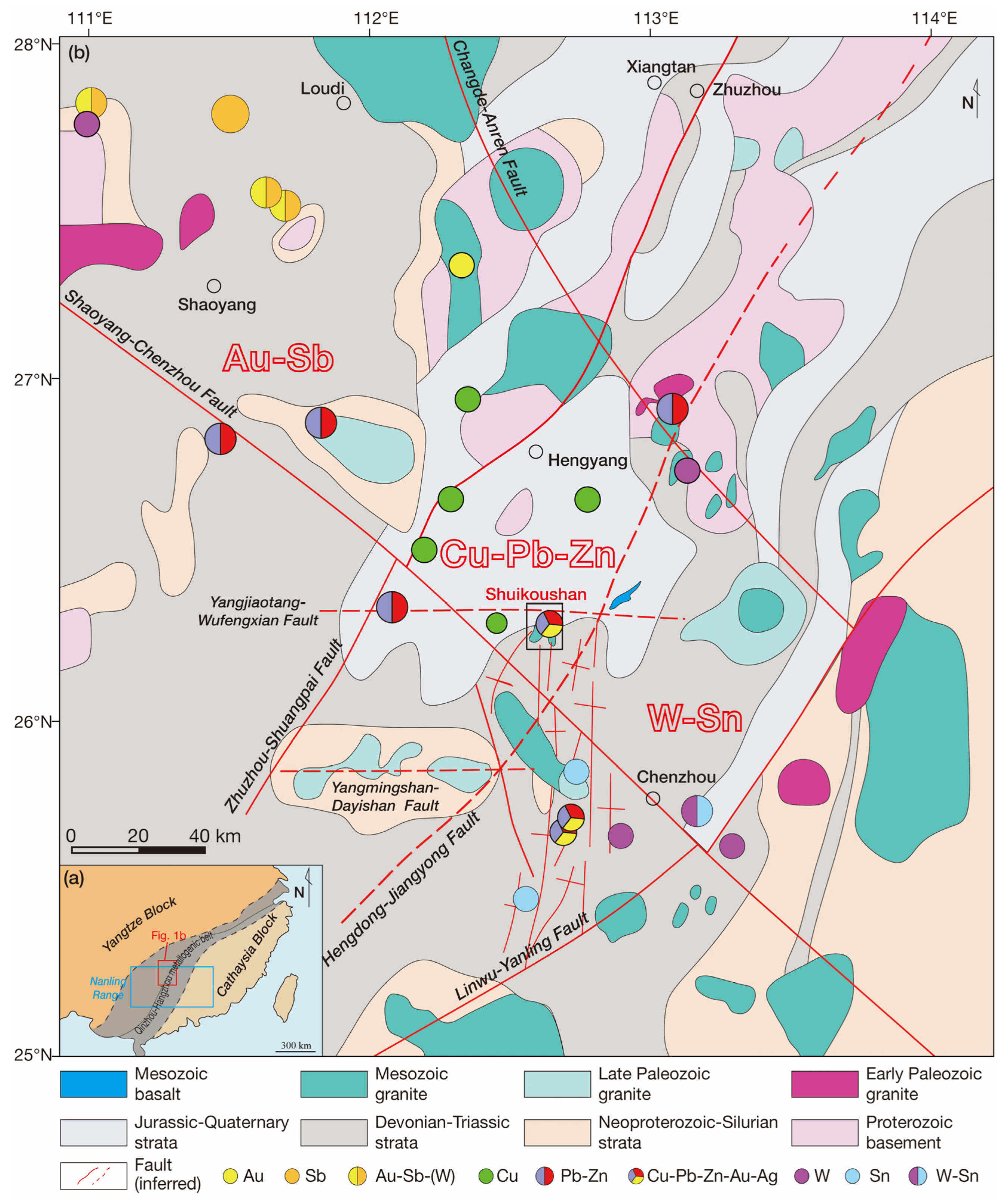
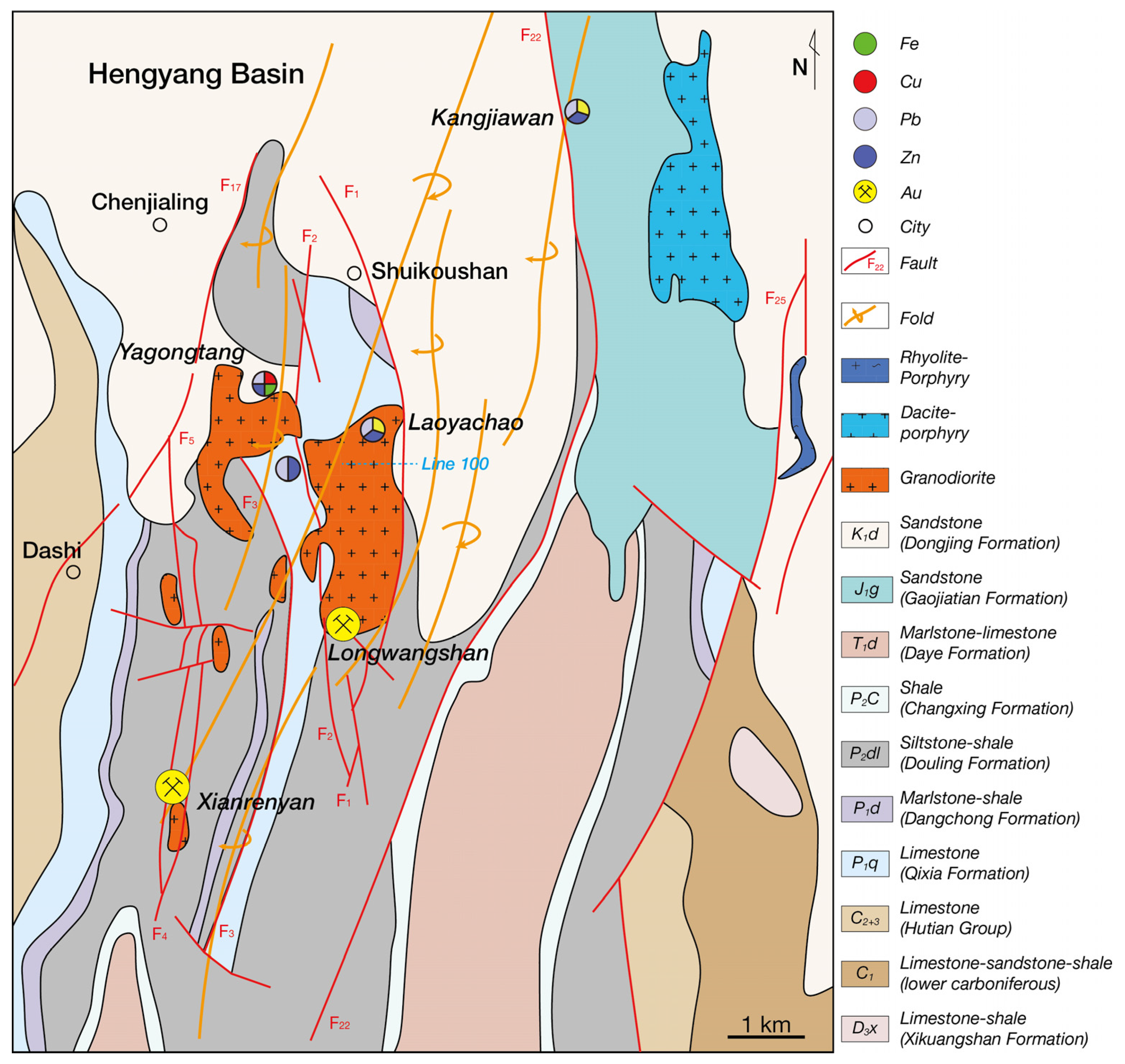
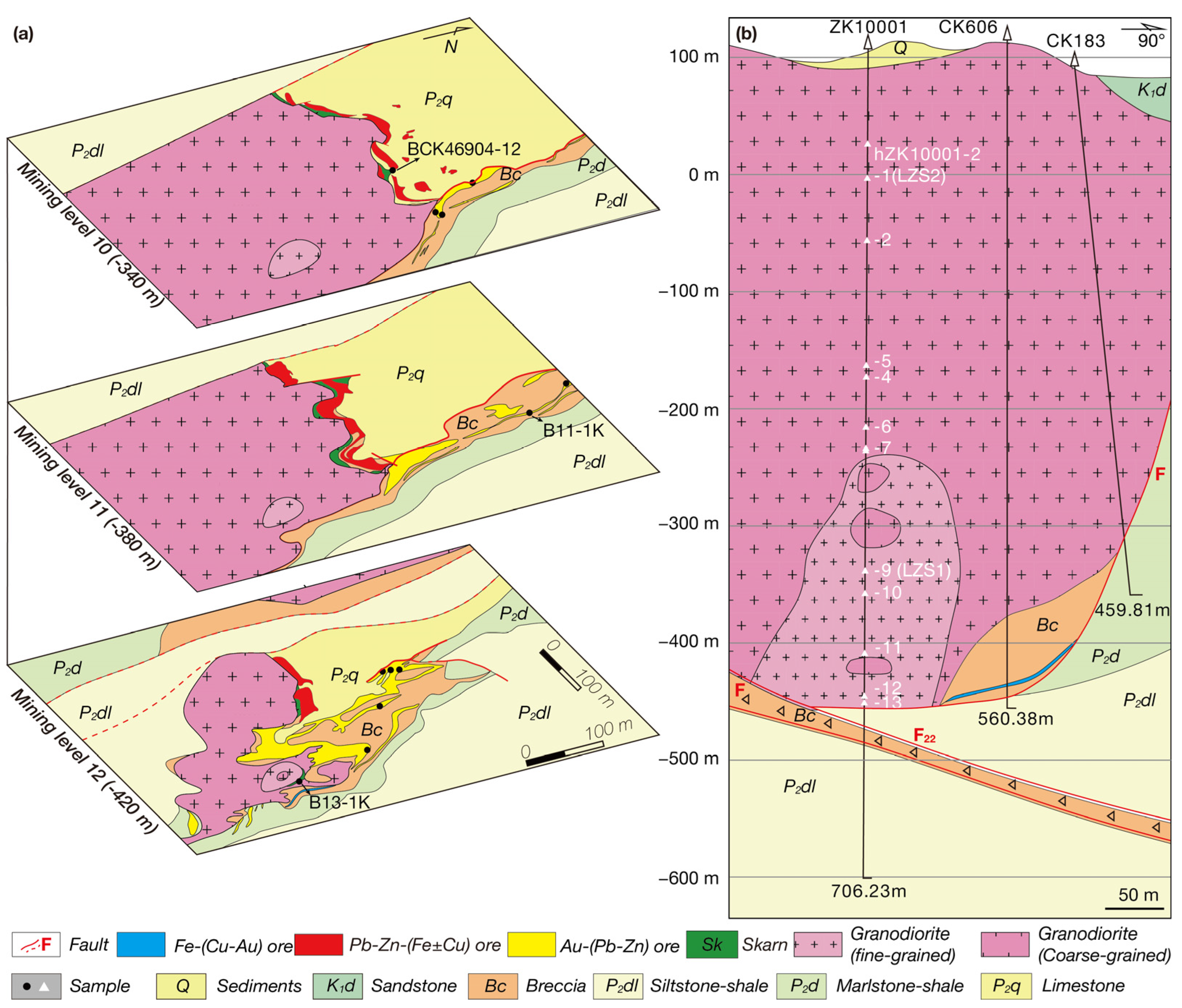
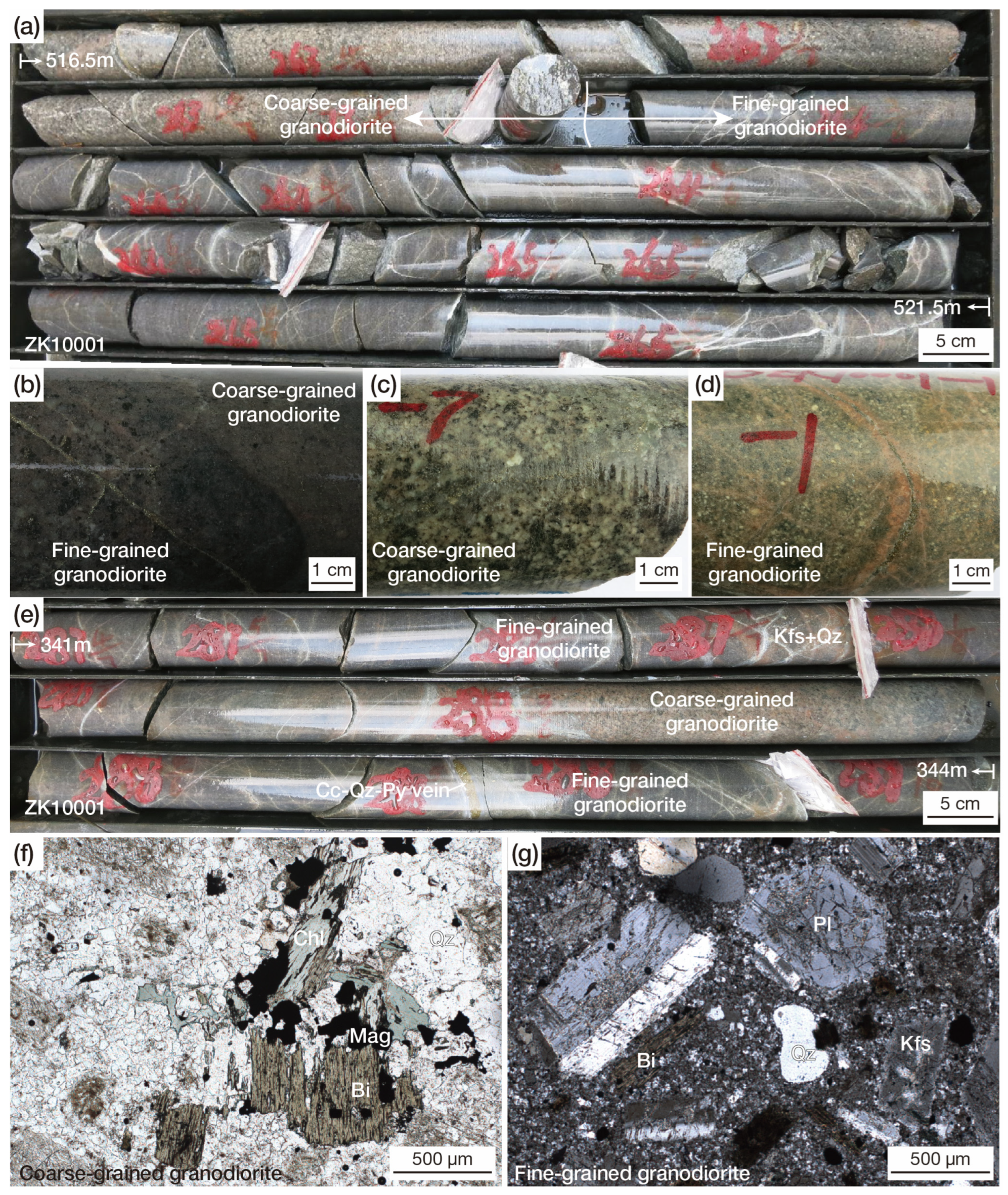
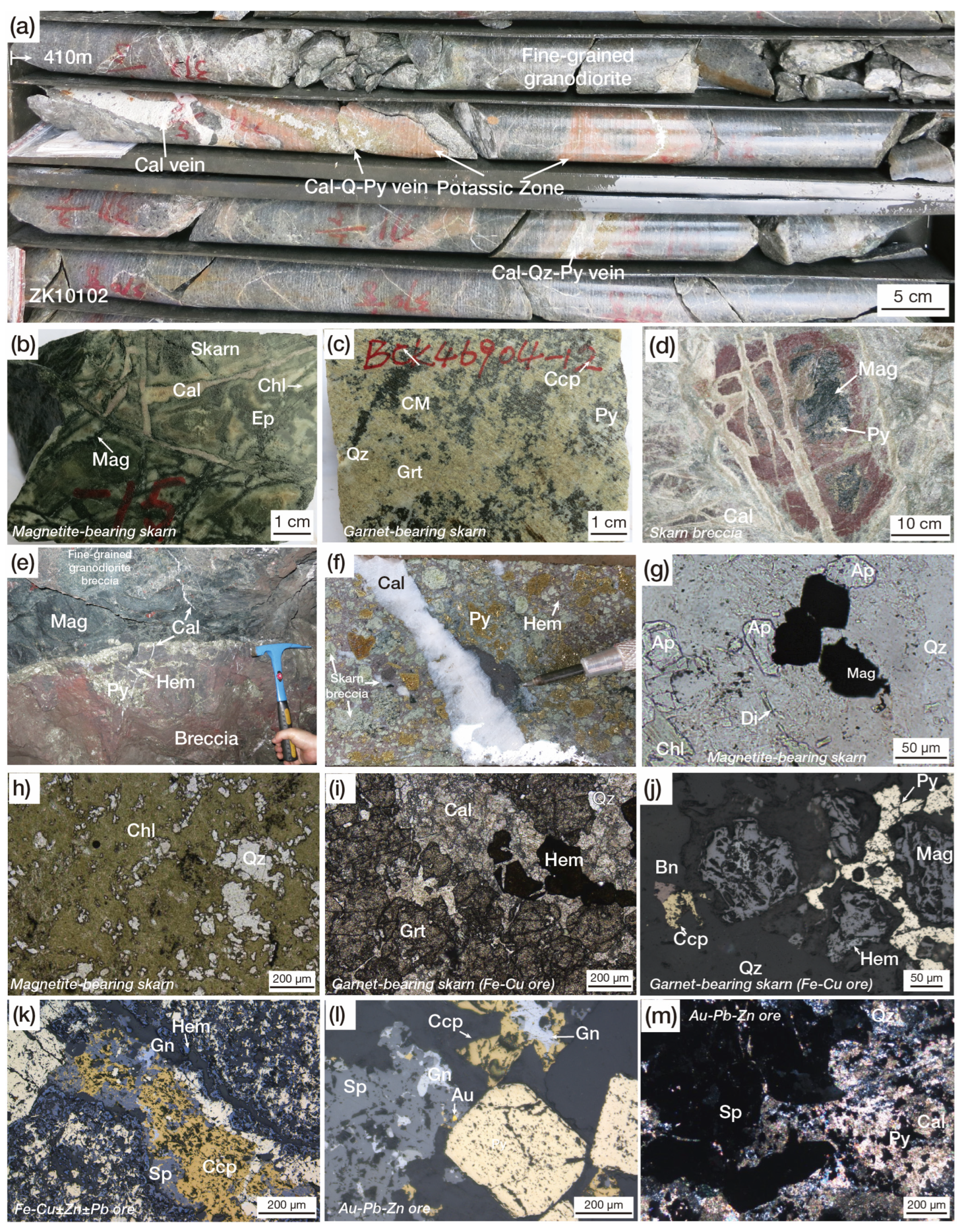

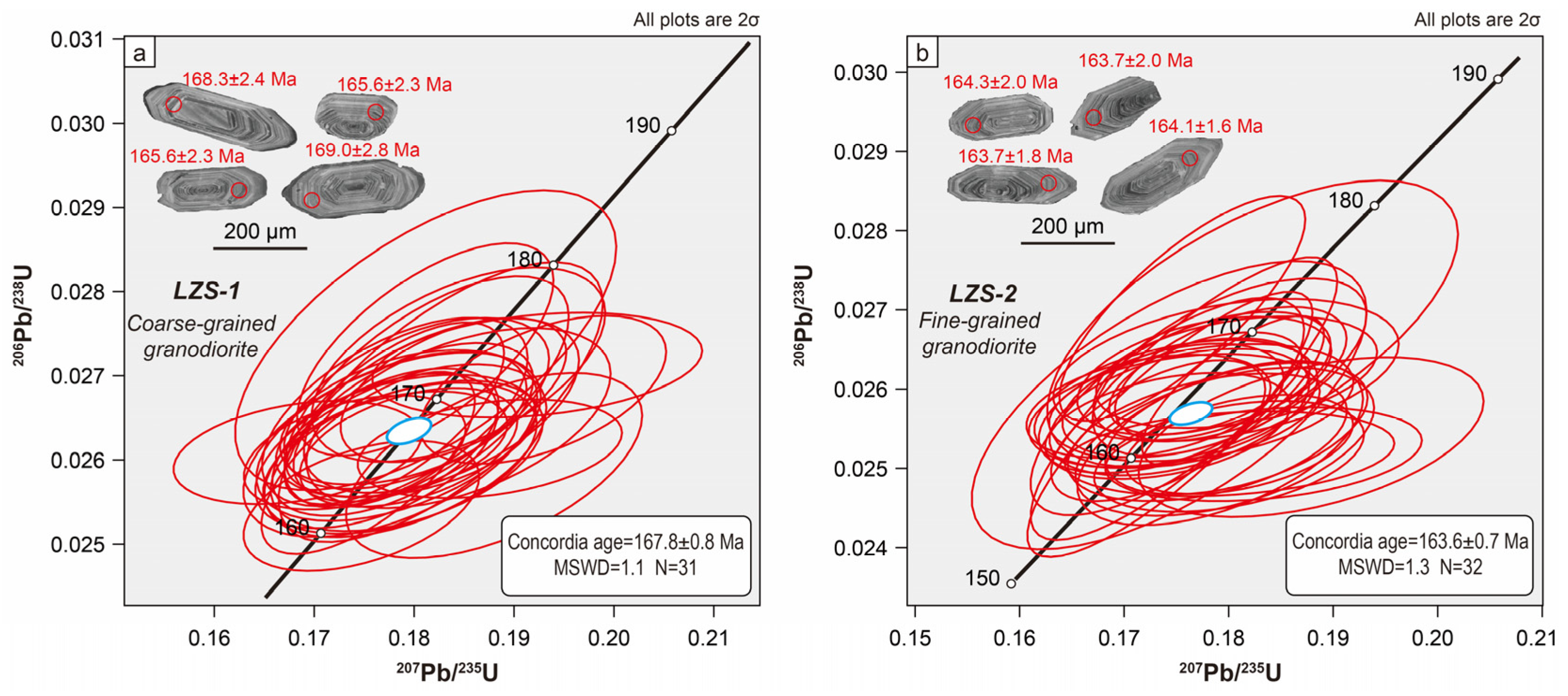

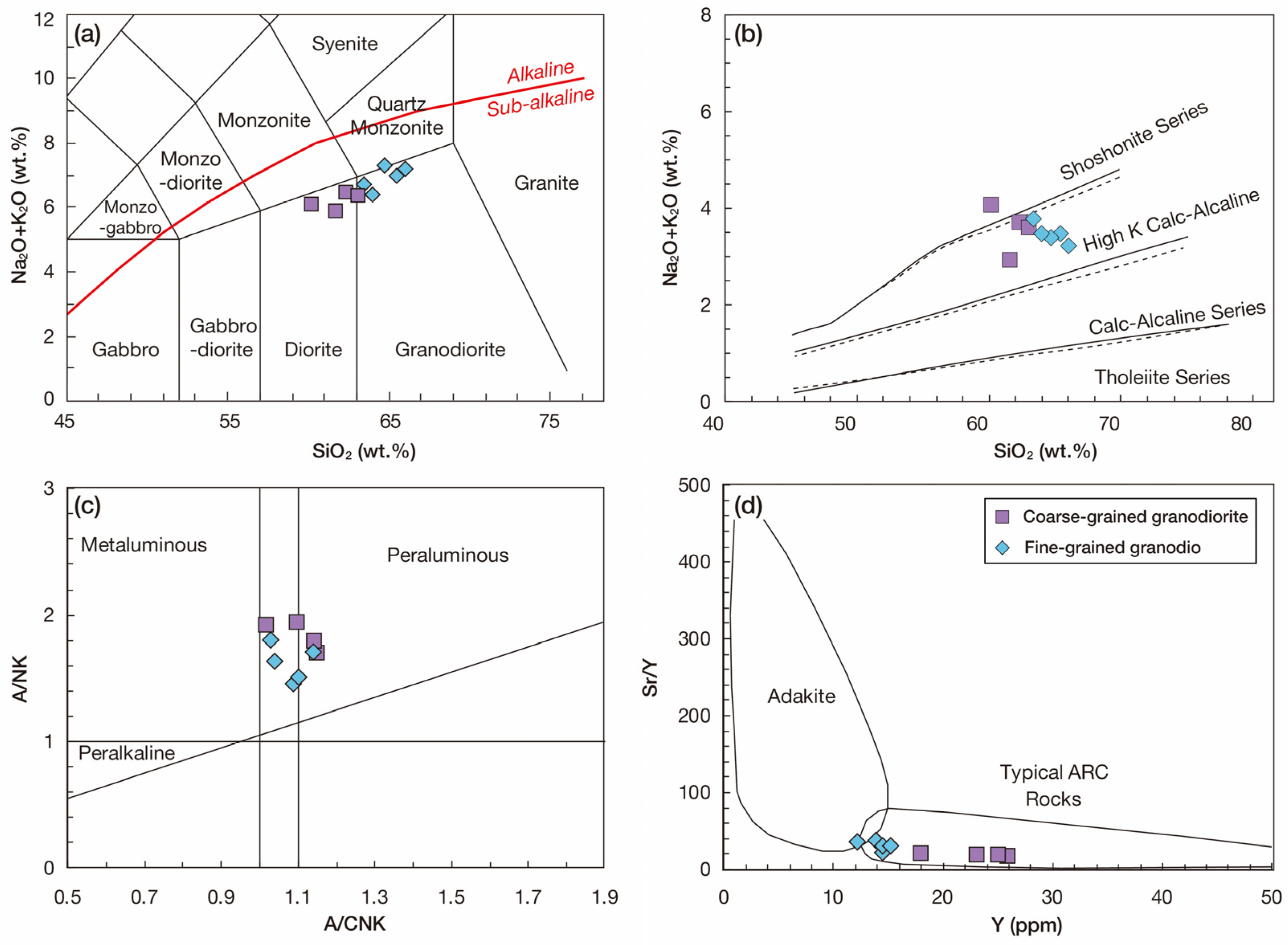

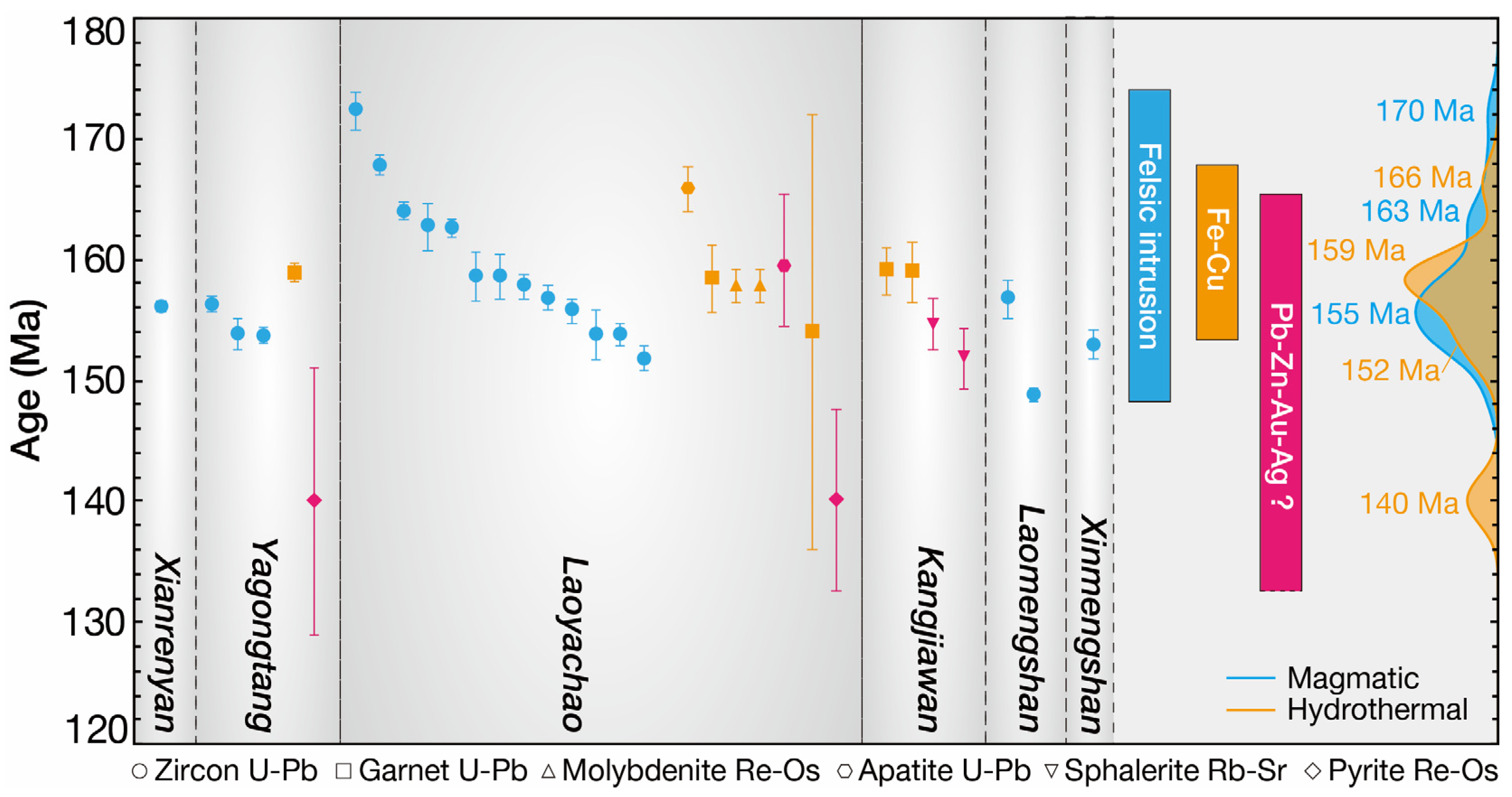
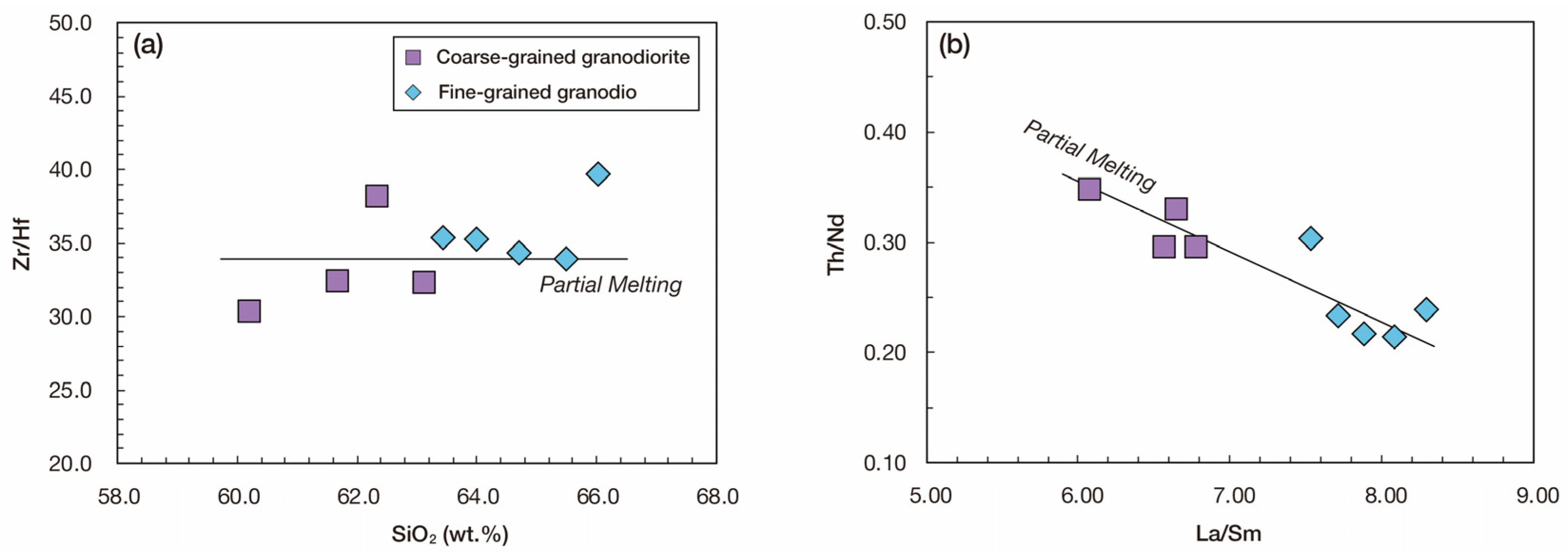
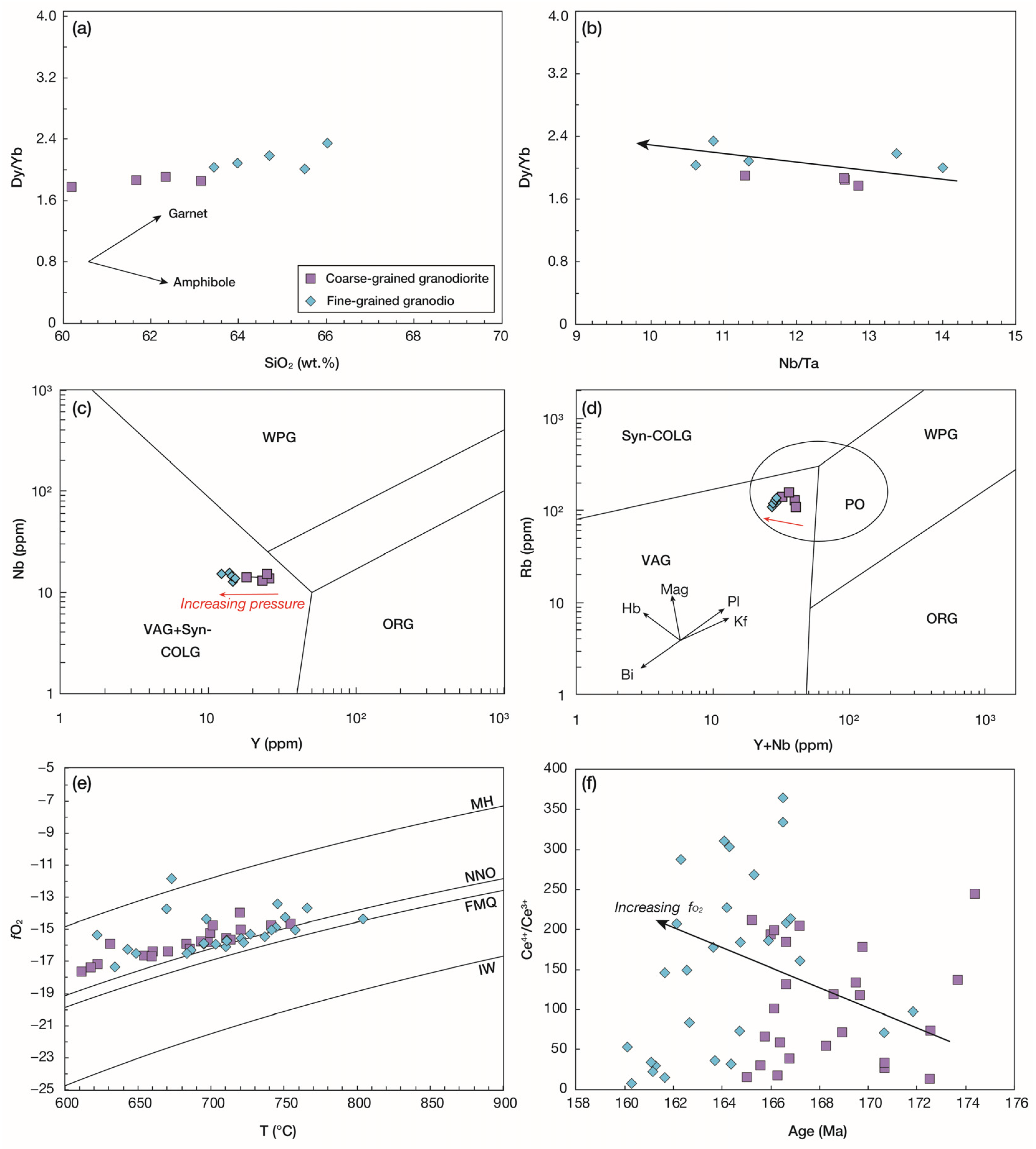
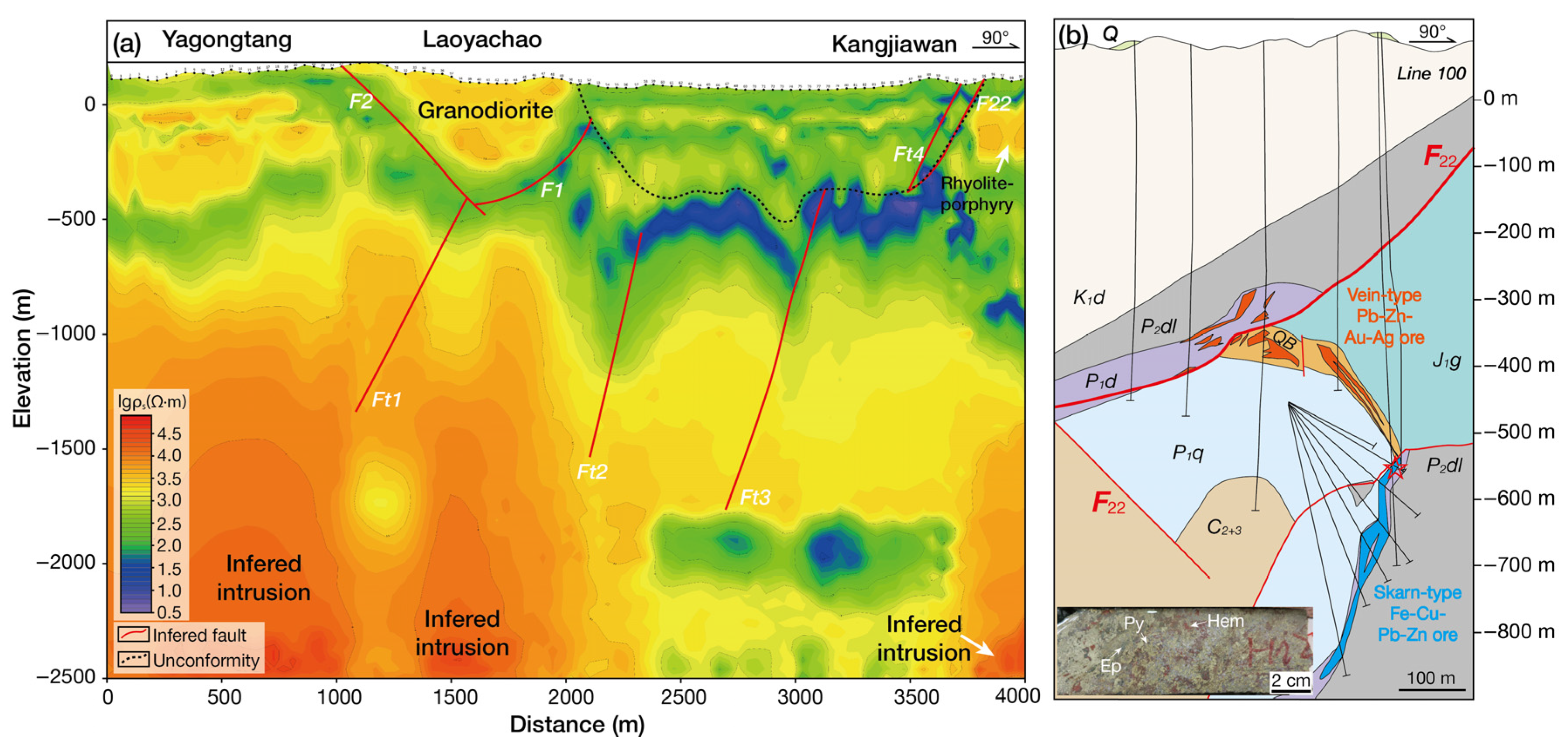
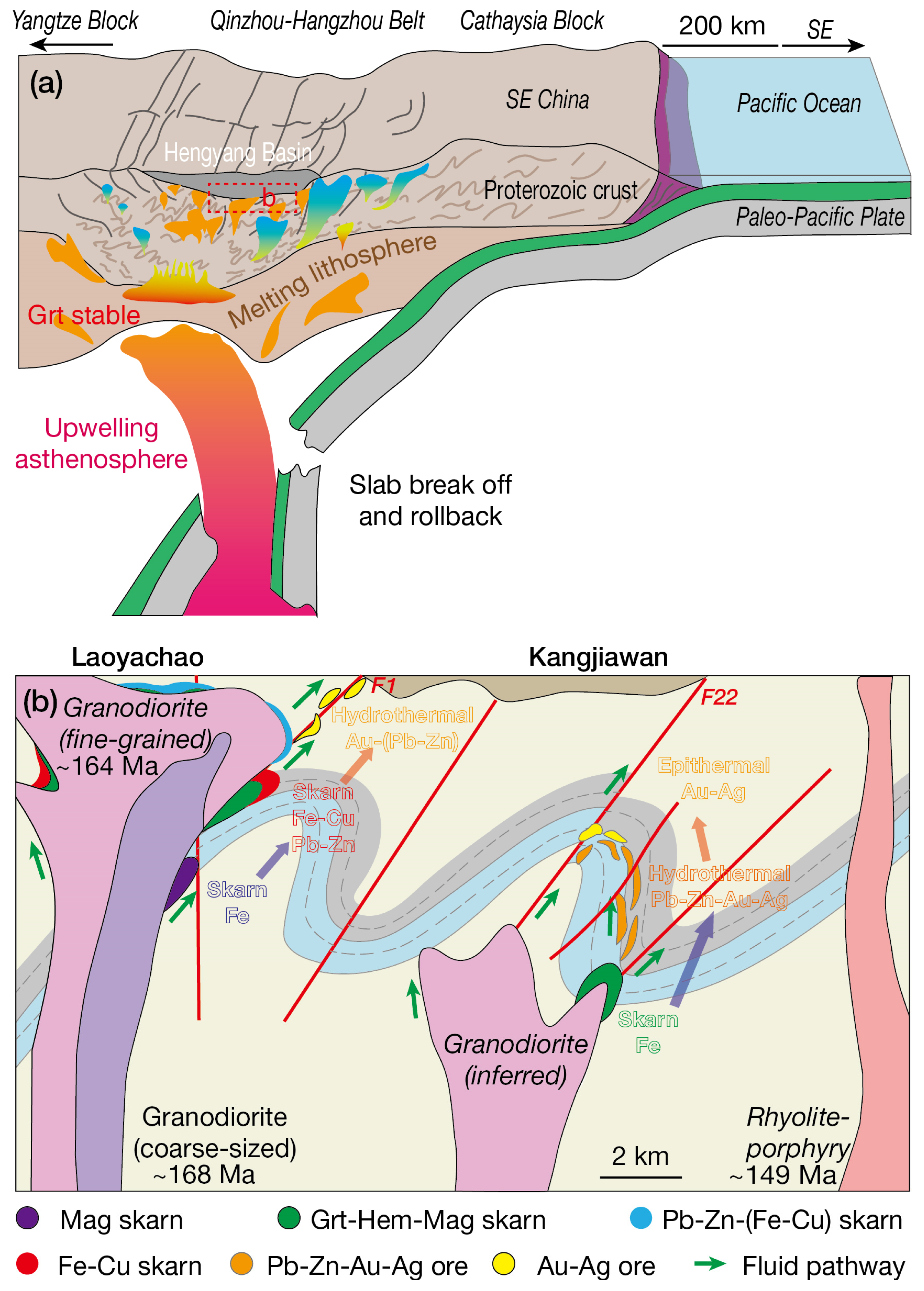
Disclaimer/Publisher’s Note: The statements, opinions and data contained in all publications are solely those of the individual author(s) and contributor(s) and not of MDPI and/or the editor(s). MDPI and/or the editor(s) disclaim responsibility for any injury to people or property resulting from any ideas, methods, instructions or products referred to in the content. |
© 2023 by the authors. Licensee MDPI, Basel, Switzerland. This article is an open access article distributed under the terms and conditions of the Creative Commons Attribution (CC BY) license (https://creativecommons.org/licenses/by/4.0/).
Share and Cite
Wang, J.; Du, Y.; Zhang, F.; Li, Q.; Zuo, C.; Zhang, X.; Wang, Y.; Wu, J.; Ma, S. Deeply Derived Magma Controlling the Polymetallic Mineralization at Shuikoushan, South China: Constraints from Mineral U–Pb Dating and Whole-Rock Geochemistry. Minerals 2023, 13, 1508. https://doi.org/10.3390/min13121508
Wang J, Du Y, Zhang F, Li Q, Zuo C, Zhang X, Wang Y, Wu J, Ma S. Deeply Derived Magma Controlling the Polymetallic Mineralization at Shuikoushan, South China: Constraints from Mineral U–Pb Dating and Whole-Rock Geochemistry. Minerals. 2023; 13(12):1508. https://doi.org/10.3390/min13121508
Chicago/Turabian StyleWang, Jionghui, Yulong Du, Fanghua Zhang, Qiushi Li, Changhu Zuo, Xi Zhang, Yong Wang, Jiangwei Wu, and Shengchao Ma. 2023. "Deeply Derived Magma Controlling the Polymetallic Mineralization at Shuikoushan, South China: Constraints from Mineral U–Pb Dating and Whole-Rock Geochemistry" Minerals 13, no. 12: 1508. https://doi.org/10.3390/min13121508





